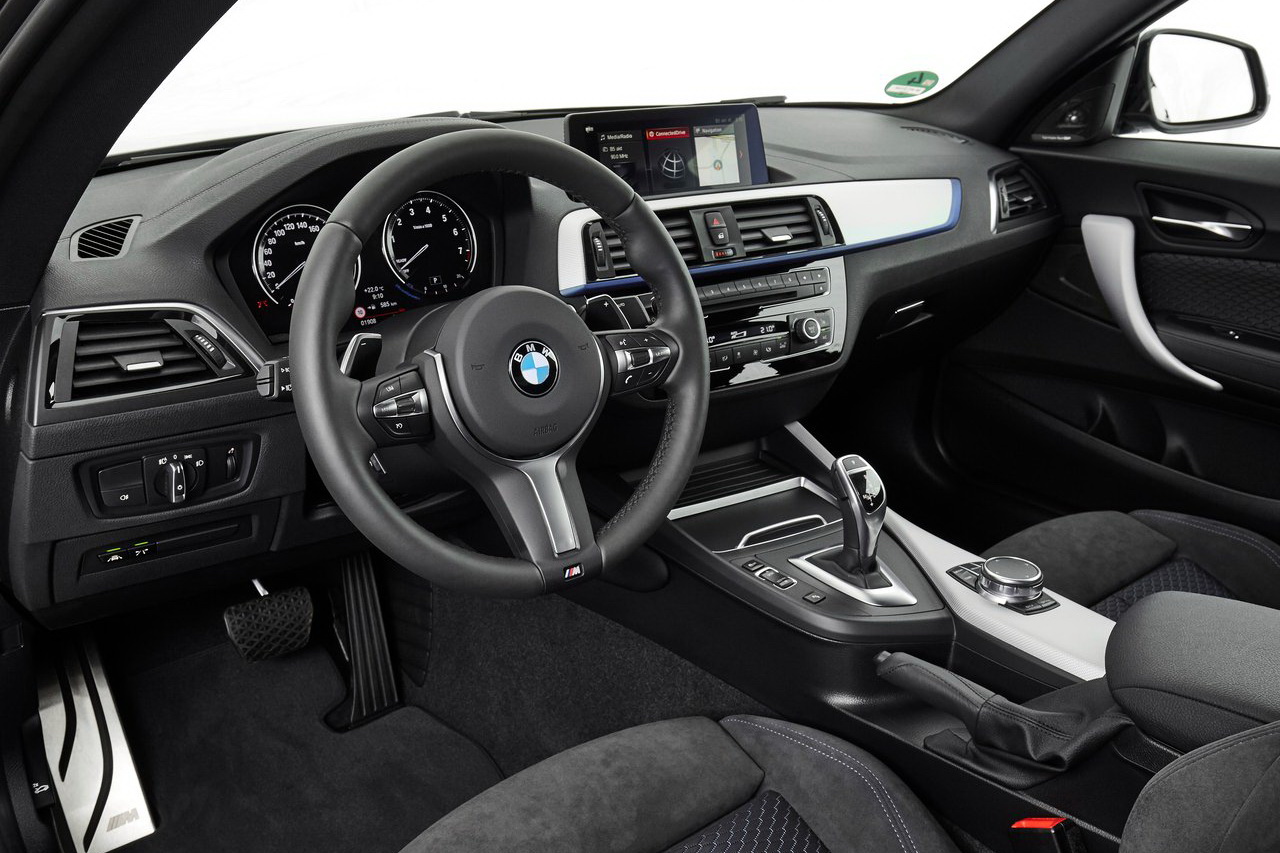

When BMW launched the BMW 2-Series Coupe and BMW 2-Series Convertible, it raised the bar in the premium compact class in terms of dynamic prowess, aesthetic appeal and emotional richness. And the new generation of the two models promises to build on this success when it is launched in July 2017. Rear-wheel drive (unique in the segment) and efficient drive systems link up to provide unbeatable sports performance, excellent ride comfort shares centre stage with razor-sharp dynamics, and emotional depth is combined with an air of elegance. All that remains is the choice of Coupe

The BMW 2-Series Coupe: compact, athletic
The BMW 2-Series Coupe has been on the market since 2014, standing out alluringly from the rest of its segment with an overall concept featuring, in time-honoured BMW coupe style, a two-door body with classical three-box design, four seats and rear-wheel drive, plus engines and suspension tuned to deliver sporting responses. It is a recipe further enhanced by the everyday practicality of the 4,432-millimetre-long BMW 2-Series Coupe, which has a boot capacity of 390 litres.

The BMW 2-Series Coupe enjoy success around the world
Exterior and lighting design
A low-slung silhouette, dynamically stretched lines with compact proportions and powerfully contoured surfaces accentuate the sporting credentials and elegance of both the BMW 2-Series Coupe and BMW 2-Series Convertible. And with the changing of the guard from outgoing model to new comes a new and more striking front end for both cars.

The kidney grille on the new models is endowed with greater presence and brings extra visual breadth to the front end. The links between the headlights and the kidney grille, together with the light graphic, ensure the nose of the Coupe and Convertible projects a sportier impression. The outer air intakes in the three-section front end are now larger, while two horizontal bars emphasise the cars’ powerful stance on the road.
The rear of the BMW 2-Series Coupe and BMW 2-Series Convertible likewise cuts a wide and muscular figure. Its stylistic impact is reinforced by the singlepiece rear lights (LEDs as standard) with hallmark BMW L-shape, which extend well into the flanks.

Interior and equipment
A completely redesigned instrument panel with an even more pronounced driver-focused layout, plus new materials that lend further substance to the upmarket and exclusive character of the BMW 2-Series Coupe and BMW 2-Series Convertible ensure the new model generation can be clearly distinguished from its predecessor inside as well as out.
The instrument panel’s makeover completely changes the overall impression created by the new BMW 2-Series cabin. There are now far fewer joins, giving the interior a roomier, calmer, more clean-cut appearance, at the same time as emphasising its width. And a host of other details also help to accentuate the elegant design. On Sport Line, Luxury Line and M Sport models, contrast stitching is used for the seams. The centre stack, which houses the control panels for the radio and air conditioning systems, has a high-gloss black finish that gives the main element nestled between the central display and transmission tunnel an even more exclusive and sophisticated feel.

Engines, powertrain, chassis
An extensive line-up of three-, four- and six-cylinder engines is available for the BMW 2-Series Coupe and BMW 2-Series Convertible, producing outputs from 100 kW/136 hp to 250 kW/340 hp (fuel consumption combined: 8.3 – 3.8 l/100 km [34.0 – 74.3 mpg imp]; CO2 emissions combined: 189 – 101 g/km). All the petrol and diesel engines are from the latest BMW EfficientDynamics engine family and feature BMW TwinPower Turbo technology. In addition to a basic concept that is inherently more efficient, all the diesel engines feature new turbocharger technology and enhanced common-rail direct injection systems.
BMW 2-Series Coupe customers can choose from nine engine options, including five petrol variants. The three-cylinder unit earmarked for the 218i develops 100 kW/136 hp (fuel consumption combined: 5.6 – 5.1 l/100 km [50.4 – 55.4 mpg imp]; CO2 emissions combined: 130 – 118 g/km). And the four-cylinder engines offer 135 kW/184 hp in the 220i (fuel consumption combined: 5.9 – 5.5 l/100 km [47.9 – 51.4 mpg imp]; CO2 emissions combined: 136 – 127 g/km) or 185 kW/252 hp in the 230i (fuel consumption combined: 5.9 – 5.7 l/100 km [47.9 – 49.6 mpg imp]; CO2 emissions combined: 134 – 131 g/km).

And then there is the six-cylinder engine powering the BMW M240i M Performance model. This turbocharged straight-six generates 250 kW/340 hp and has combined fuel consumption of 7.8 – 7.1 l/100 km [36.2 – 39.8 mpg imp]. CO2 emissions are 179 – 163 g/km. The BMW M240i xDrive all-wheeldrive model returns combined fuel consumption of 7.4 l/100 km [38.2 mpg imp] and CO2 emissions of 169 g/km.
Diesel variants of the BMW 2-Series Coupe come in 218d, 220d/220d xDrive and 225d forms. Outputs stretch from 110 kW/150 hp via 140 kW/190 hp to 165 kW/224 hp (fuel consumption combined: 4.7 – 3.8 l/100 km [60.1 – 74.3 mpg imp]; CO2 emissions combined: 124 – 101 g/km).


When BMW launched the BMW 2-Series Coupe and BMW 2-Series Convertible, it raised the bar in the premium compact class in terms of dynamic prowess, aesthetic appeal and emotional richness. And the new generation of the two models promises to build on this success when it is launched in July 2017. Rear-wheel drive (unique in the segment) and efficient drive systems link up to provide unbeatable sports performance, excellent ride comfort shares centre stage with razor-sharp dynamics, and emotional depth is combined with an air of elegance. All that remains is the choice of Coupe

The BMW 2-Series Coupe: compact, athletic
The BMW 2-Series Coupe has been on the market since 2014, standing out alluringly from the rest of its segment with an overall concept featuring, in time-honoured BMW coupe style, a two-door body with classical three-box design, four seats and rear-wheel drive, plus engines and suspension tuned to deliver sporting responses. It is a recipe further enhanced by the everyday practicality of the 4,432-millimetre-long BMW 2-Series Coupe, which has a boot capacity of 390 litres.

The BMW 2-Series Coupe enjoy success around the world
Exterior and lighting design
A low-slung silhouette, dynamically stretched lines with compact proportions and powerfully contoured surfaces accentuate the sporting credentials and elegance of both the BMW 2-Series Coupe and BMW 2-Series Convertible. And with the changing of the guard from outgoing model to new comes a new and more striking front end for both cars.

The kidney grille on the new models is endowed with greater presence and brings extra visual breadth to the front end. The links between the headlights and the kidney grille, together with the light graphic, ensure the nose of the Coupe and Convertible projects a sportier impression. The outer air intakes in the three-section front end are now larger, while two horizontal bars emphasise the cars' powerful stance on the road.
The rear of the BMW 2-Series Coupe and BMW 2-Series Convertible likewise cuts a wide and muscular figure. Its stylistic impact is reinforced by the singlepiece rear lights (LEDs as standard) with hallmark BMW L-shape, which extend well into the flanks.

Interior and equipment
A completely redesigned instrument panel with an even more pronounced driver-focused layout, plus new materials that lend further substance to the upmarket and exclusive character of the BMW 2-Series Coupe and BMW 2-Series Convertible ensure the new model generation can be clearly distinguished from its predecessor inside as well as out.
The instrument panel's makeover completely changes the overall impression created by the new BMW 2-Series cabin. There are now far fewer joins, giving the interior a roomier, calmer, more clean-cut appearance, at the same time as emphasising its width. And a host of other details also help to accentuate the elegant design. On Sport Line, Luxury Line and M Sport models, contrast stitching is used for the seams. The centre stack, which houses the control panels for the radio and air conditioning systems, has a high-gloss black finish that gives the main element nestled between the central display and transmission tunnel an even more exclusive and sophisticated feel.

Engines, powertrain, chassis
An extensive line-up of three-, four- and six-cylinder engines is available for the BMW 2-Series Coupe and BMW 2-Series Convertible, producing outputs from 100 kW/136 hp to 250 kW/340 hp (fuel consumption combined: 8.3 - 3.8 l/100 km [34.0 - 74.3 mpg imp]; CO2 emissions combined: 189 - 101 g/km). All the petrol and diesel engines are from the latest BMW EfficientDynamics engine family and feature BMW TwinPower Turbo technology. In addition to a basic concept that is inherently more efficient, all the diesel engines feature new turbocharger technology and enhanced common-rail direct injection systems.
BMW 2-Series Coupe customers can choose from nine engine options, including five petrol variants. The three-cylinder unit earmarked for the 218i develops 100 kW/136 hp (fuel consumption combined: 5.6 - 5.1 l/100 km [50.4 - 55.4 mpg imp]; CO2 emissions combined: 130 - 118 g/km). And the four-cylinder engines offer 135 kW/184 hp in the 220i (fuel consumption combined: 5.9 - 5.5 l/100 km [47.9 - 51.4 mpg imp]; CO2 emissions combined: 136 - 127 g/km) or 185 kW/252 hp in the 230i (fuel consumption combined: 5.9 - 5.7 l/100 km [47.9 - 49.6 mpg imp]; CO2 emissions combined: 134 - 131 g/km).

And then there is the six-cylinder engine powering the BMW M240i M Performance model. This turbocharged straight-six generates 250 kW/340 hp and has combined fuel consumption of 7.8 - 7.1 l/100 km [36.2 - 39.8 mpg imp]. CO2 emissions are 179 - 163 g/km. The BMW M240i xDrive all-wheeldrive model returns combined fuel consumption of 7.4 l/100 km [38.2 mpg imp] and CO2 emissions of 169 g/km.
Diesel variants of the BMW 2-Series Coupe come in 218d, 220d/220d xDrive and 225d forms. Outputs stretch from 110 kW/150 hp via 140 kW/190 hp to 165 kW/224 hp (fuel consumption combined: 4.7 - 3.8 l/100 km [60.1 - 74.3 mpg imp]; CO2 emissions combined: 124 - 101 g/km).




























